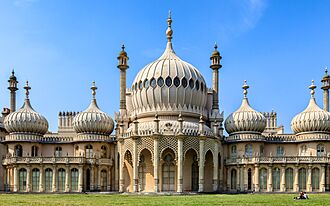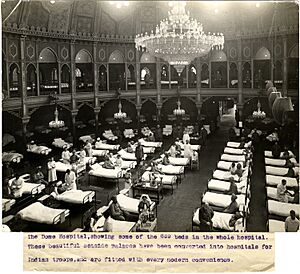Royal Pavilion facts for kids
Quick facts for kids Royal Pavilion |
|
|---|---|

View of the Royal Pavilion
|
|
| General information | |
| Type | Palace |
| Architectural style | Indo-Saracenic Revival |
| Town or city | Brighton |
| Country | England |
| Coordinates | 50°49′23″N 0°08′15″W / 50.82306°N 0.13750°W |
| Construction started | 1787 |
| Completed | 1823 |
| Owner | Royal Pavilion & Museums Trust |
| Design and construction | |
| Architect | John Nash |
The Royal Pavilion, also called the Brighton Pavilion, is a famous former royal home in Brighton, England. It has beautiful gardens around it. This amazing building was first started in 1787. It was built in three steps for George, Prince of Wales. He later became the Prince Regent in 1811 and then King George IV in 1820.
The Pavilion looks like buildings from India, with its round domes and tower-like structures. This unique style is called Indo-Saracenic. The architect John Nash gave the building its current look, starting in 1815. King George IV's family, including William IV and Queen Victoria, also used the Pavilion. However, Queen Victoria decided to sell it to the city of Brighton in 1850. She preferred Osborne House as her seaside home.
Contents
History of the Royal Pavilion
Why the Prince Came to Brighton
The Prince of Wales, who would become King George IV, first visited Brighton in 1783. He was 21 years old. Brighton was a popular seaside town back then. People liked it because of the fresh air and seawater, which was thought to be good for health. The Prince also enjoyed the fun activities in Brighton, like good food and theatre.
In 1786, the Prince rented a small farmhouse in Brighton. It was a quiet place away from London. He wanted a private spot to relax.
How the Pavilion Changed Over Time
In 1787, the Prince asked an architect named Henry Holland to make the farmhouse bigger. It became part of a building called the Marine Pavilion. It had a central area with a breakfast room, dining room, and library. These rooms were decorated in a fancy French style.
Later, in 1801–02, the Pavilion was made even larger. New rooms were added, including a dining room and a conservatory. The Prince also bought land around the building. On this land, large stables for 60 horses were built. These stables looked like Indian buildings and were designed by William Porden.
Between 1815 and 1822, John Nash completely redesigned the Pavilion. This is the amazing building we see today. Its outside looks like buildings from India and the Middle East. The inside is also very unique, with designs inspired by Chinese and Indian styles. Some people compare the Royal Pavilion's look to the Taj Mahal in India because of its domes and towers. It was a very exotic and fashionable style for its time.
The City of Brighton Buys the Pavilion
After King George IV passed away in 1830, his brother William IV continued to use the Pavilion. But Queen Victoria did not like Brighton very much. She felt there was not enough privacy. Also, Brighton became very popular with many people visiting by train after 1841. The Pavilion felt too small for her growing family. Queen Victoria famously said she disliked the constant attention she received there.
She decided to buy land on the Isle of Wight to build Osborne House. This became the new royal summer home. In 1845, after her last visit to Brighton, the government planned to sell the Royal Pavilion. The people of Brighton wanted to keep it. So, in 1850, the city of Brighton bought the Pavilion and its grounds for £53,000. This money helped pay for the furniture at Osborne House.
In 1860, the old royal stables next to the Pavilion were turned into a concert hall. Today, it is known as the Brighton Dome. Many of the Pavilion's original items were moved to Buckingham Palace or Windsor Castle when it was sold. However, Queen Victoria later returned many unused items in the 1860s. King George V and Queen Mary returned even more furniture after the First World War.
Since the end of the Second World War, Brighton has worked hard to make the Pavilion look like it did when King George IV lived there. Queen Elizabeth II helped by lending over 100 pieces of furniture in the 1950s. The city has been restoring the rooms, adding back walls, and making copies of original decorations and furniture.
In 2020, a new charity called the Royal Pavilion & Museums Trust took over managing the Royal Pavilion and its collections.
The Royal Pavilion During the First World War

During the First World War, the Royal Pavilion became a military hospital. From December 1914 to January 1916, it treated sick and wounded soldiers from the Indian Army. Many brave Indian soldiers who received the Victoria Cross were treated here. The hospital also used the nearby Brighton Dome and Corn Exchange buildings.
The Pavilion hospital had two operating rooms and over 720 beds. More than 2,300 Indian soldiers were treated there. Special arrangements were made for their different religions and cultures. Nine different kitchens were set up so soldiers could have food cooked by people from their own groups. Muslim soldiers could pray facing Mecca on the eastern lawns. Sikh soldiers had a special tented gurdwara (a Sikh temple) in the grounds.
The government wanted to show that Indian soldiers were being well cared for. So, many photos were taken of the beautiful rooms turned into hospital wards. Important people like Lord Kitchener and King George V visited the soldiers. King George V even gave military awards to some soldiers.
The hospital for Indian soldiers closed in January 1916. Most of the Indian Army had moved from France to the Middle East.
The Pavilion reopened as a hospital in April 1916. This time, it treated British soldiers who had lost arms or legs. Besides physical care, the hospital also helped these soldiers learn new skills and trades. The Pavilion hospital stayed open until the summer of 1920. Then, the building was given back to Brighton Corporation.
In 1921, a new gateway in an Indian style was opened. It was a gift from the Maharaja of Patiala to remember the Pavilion's role in treating Indian soldiers during the war.
The Royal Pavilion Today
Visiting the Pavilion
When Brighton bought the Royal Pavilion from Queen Victoria, it became a public attraction. Today, about 400,000 people visit the Royal Pavilion every year. You can take pictures and videos inside the building. Many of the items you see inside are on loan, especially from the King.
Weddings at the Pavilion
The Royal Pavilion is also a place where people can get married. On March 29, 2014, it was one of the first places in the United Kingdom to host a legal same-sex marriage.
The Royal Pavilion Garden
The Royal Pavilion Garden is a beautiful part of the grounds. It has many different plants and has been restored to look like it did in the early 1800s. It is said to be the only fully restored garden from that time in the UK. A team of gardeners and volunteers takes care of the garden using only natural methods.
The garden is a popular spot for street performers, especially in the summer. There is also a café there.
The garden is a protected historical site. In 2017, it was listed as "at risk" because of things like fences and litter bins that spoiled its original look. The city council asked the public for ideas on how to protect the gardens. There were also reports of many incidents, which led to discussions about possibly fencing off the gardens and closing them at night for safety.
Images for kids
See also
 In Spanish: Royal Pavilion para niños
In Spanish: Royal Pavilion para niños
- Grade I listed buildings in Brighton and Hove






